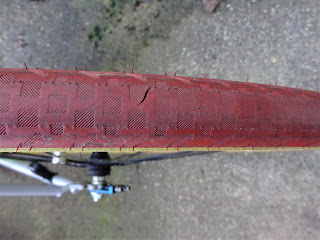There’s a natural rhythm to our
machines, and we quickly cultivate an ear for anything different. You know the
ones. Intermittent clicks, squeaks, rattles that induce in-the-saddle
diagnostics.
Dancing on the pedals, while
climbing to rule out a poorly pedal, grumbling bottom bracket, loose crank…No,
Hmmm, hope that’s not the free/hub…Stop, waggle, probe. Nothing… UN55 bottom
bracket seemed fine, bars snug, ditto mudguard hardware.
Every few rotations of the
crank, came a dull, faint clicking. Loose seat post clamp? Subtle bouncing on
the saddle, dismissed this idea. Coasting suggested the Deore hub wasn’t
heading for oblivion, either-mercifully.
Final climb reduced potential
culprits to pedal, or crank. Sure enough, introducing my workshop length 8mm
into the left-hand arm, revealed the bolt was a little loose-hence the creak. I
was four complete turns before it wound drum tight.
This also prompted a quick
tweak of cockpit, saddle and mudguard fasteners. Oh, and a pedal swap for good
measure. Celebrations proved a little previous. The following day, we were
battling high winds, when click, click…Bong! Yep, the ultra-reliable UN55 cartridge
bottom bracket, had finally got the grumbles.
Ironically enough, this Cyclo
20 function multi tool arrived, shortly after. There’s a temptation to suggest
more is better, when it comes to functions. However, usability is another big
factor, especially when tackling adjustments/repairs by the road and trail side.
These feature long tool bits, great for torque and/or stubborn fasteners, there’s a chain tool, and integral tyre lever, should you forget to pack one.
These feature long tool bits, great for torque and/or stubborn fasteners, there’s a chain tool, and integral tyre lever, should you forget to pack one.
I’m pleased to note this
features a 15mm wrench, for solid axles. However, sometimes, smaller S shaped
keys are more convenient for tighter spaces. Including mudguard bridge bolts, saddle
clamp fasteners etc.
Once upon a time, panniers
were my default for day rides, touring, commuting and indeed, tag along
tugging. In the latter contexts, the attraction is obvious. Tools, spare tubes,
spare clothes, cakes, big “F*ck off” lock. Bananas, cake and other snacks are
easily carried.
Room for extra clothes, should
temperature and weather generally change, one way, or the other. Oh, and I
could always swing by the supermarket and collect some basics, en route home.
Not everyone wants to be
encumbered by a rack and I’ve become a real fan of Carradice’s SQR system which
allows compatible luggage to be whipped on/off. A ten-kilo maximum payload is
great for day rides, Audax, commuting and possibly, weekend touring.
I’ve run their cotton duck SQR
tour, on and off, for 18 years. So, I was delighted to receive their Carradry
SQR bag. This is an expandable system (14-18.5 litres), which on paper, should
rival a small/medium sized pannier.
One of the main advantages to this
system, over a pannier, when commuting in congested traffic, is the ability to
sneak through gaps more readily. Messenger bags, rucksacks and similar
rider-mounted luggage can be a serious boon. Especially for hauling laptops,
folders and similar valuables/delicates and for short distances. However, I
prefer bikes to do the carrying.
While the mighty Cotton Duck is
certainly waterproof, it’s a little trickier to wipe clean (even though the
undersides feature a protective laminate, to protect the base from mucky
water). The sonically welded fabric, only requires a damp-cloth onceover. The
other thing I love about the SQR system is its rigidity.
Climb out of the saddle and it
doesn’t bob around like the proverbial playful Lab. The one problem with this system, in my
experience is its incompatible with post mounted trailer/tagalong.
Although frankly, I’d always
opt for a chainstay mounted hitch, their lower centre of gravity has much less
impact upon the bike’s handling.
About posts; I’d only tether
anything of this genre, to metal models. Oh, and you also need a healthy amount
of seat post showing, for the SQR hitch. I’ve had to move this Lightrider PHASE
light to the seatstay https://www.sevendaycyclist.com/lightrider-phase-rear-light
Wedge packs, such as this
Axiom Grand Fondo are my limit, for carbon composites. Afterall, there’s a
reason why we use gripper pastes and lower torque, when fitting. Right, apparently John’s finished the Halo
wheel build, so I'm off to have a look...











































